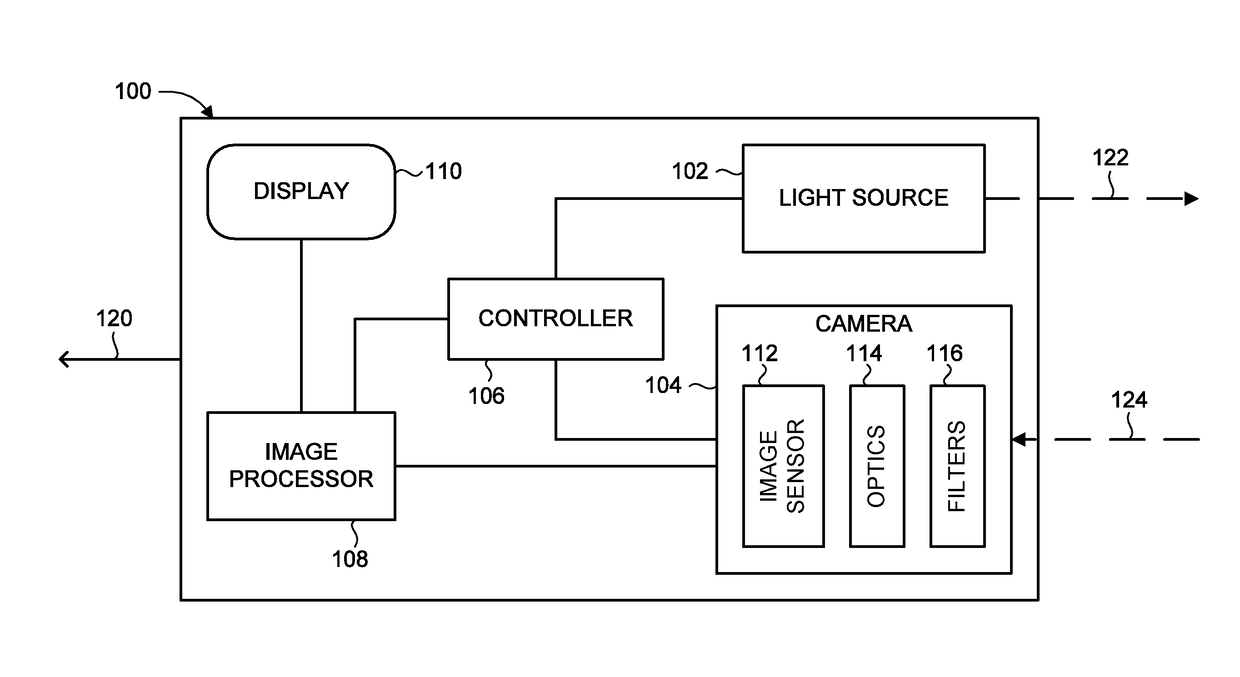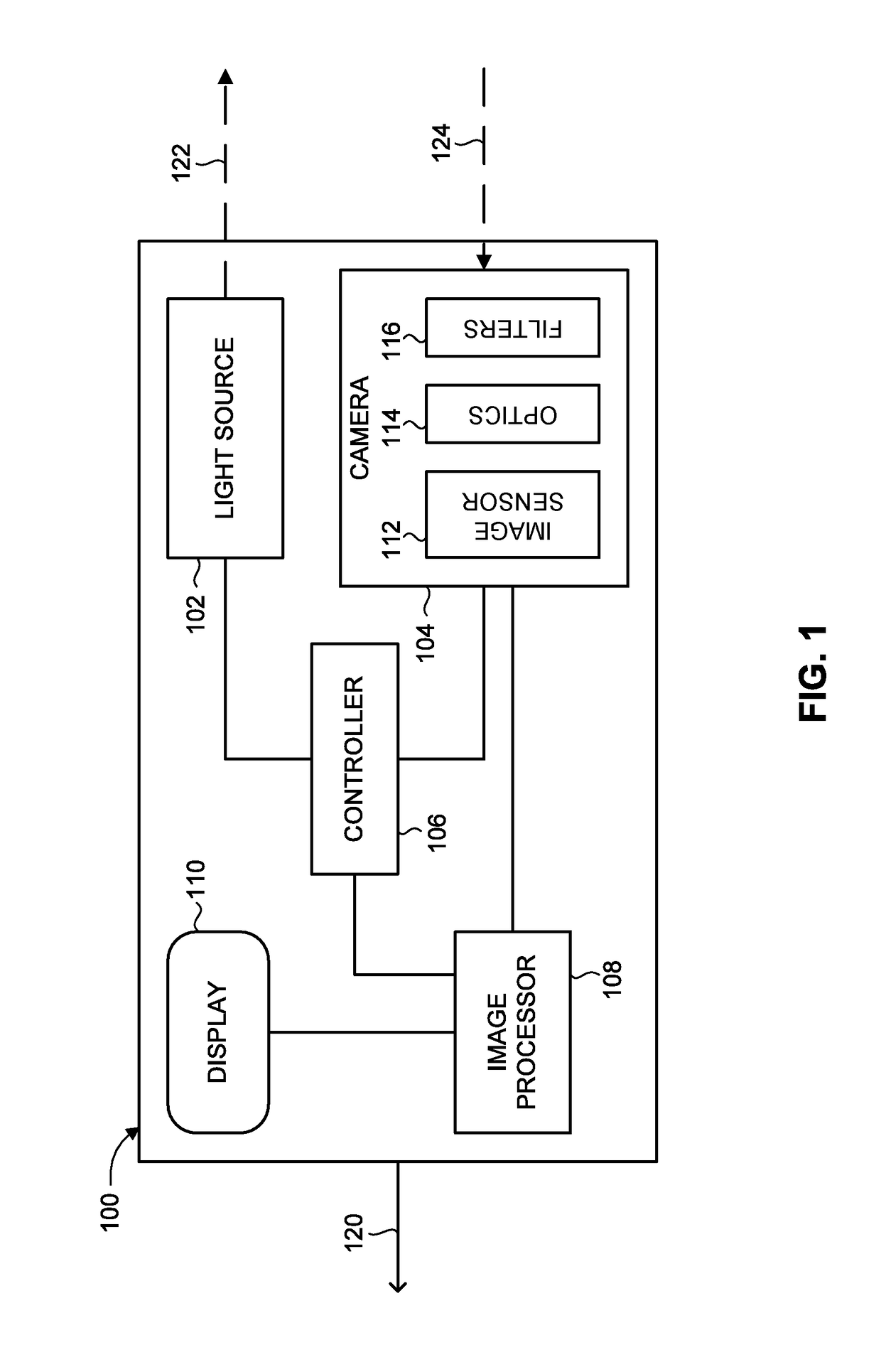High Dynamic Range Imaging of Environment with a High Intensity Reflecting/Transmitting Source
a high-dynamic range, imaging technology, applied in the field of imaging systems, can solve the problems of affecting the performance of gated and non-gated illumination-based imaging systems, leaking photons, difficult to mask memory nodes, etc., to reduce ambient light accumulation, minimize intense reflection, and minimize frame duration
- Summary
- Abstract
- Description
- Claims
- Application Information
AI Technical Summary
Benefits of technology
Problems solved by technology
Method used
Image
Examples
first embodiment
[0041]According to the present invention, the supplementary image information is obtained from a low-illumination secondary image frame acquired using a reduced illumination gating scheme. Reference is now made to FIG. 3, which is an exemplary set of image frames acquired by the imaging system (100) of FIG. 1 when implementing a first approach of supplementary imaging of high-intensity sources, operative in accordance with one embodiment of the present invention. Camera 104 acquires a first image frame (a “main image frame”), referenced 150, using a default gating scheme. Image processor 108 processes image frame 150, and identifies oversaturated image portions 152, 154, 156, arising from high-intensity sources in the imaged environment. Subsequently, camera 104 acquires a secondary image frame, referenced 160, of the same DOF as image frame 150, using a reduced-illumination gating scheme. In particular, the number of gating cycles (i.e., number of transmitted pulses / accumulated ref...
second embodiment
[0042]According to the present invention, the supplementary image information is obtained from low-illumination secondary image content that appears in the acquired image frame due to internal reflections of the reflected pulses between optical elements of the camera. Reference is now made to FIG. 4, which is an exemplary image frame, referenced 180, acquired by the imaging system (100) of FIG. 1 when implementing a second approach of supplementary imaging of high-intensity sources, operative in accordance with another embodiment of the present invention. Camera 104 acquires active-gated image frame 180. Image processor 108 processes image frame 180, and identifies oversaturated image portion 186 arising from a high-intensity source in the imaged environment. Image processor 108 further identifies, in the same image frame 180, a reduced-illumination secondary image portion 188, which contains image content respective of oversaturated image portion 186. In particular, secondary image...
third embodiment
[0043]According to the present invention, the supplementary image information is obtained from a low-illumination secondary image frame acquired by residual photo accumulation when image sensor 112 is in a non-exposure state. Reference is now made to FIGS. 5A and 5B. FIG. 5A is an exemplary first image frame, referenced 190, with oversaturated image portions, acquired by the imaging system (100) of FIG. 1, operative in accordance with a further embodiment of the present invention. FIG. 5B is an exemplary secondary image frame, referenced 200, acquired by the imaging system (100) of FIG. 1, corresponding to the image frame of FIG. 5A, when implementing a third approach of supplementary imaging of high-intensity sources, operative in accordance with a further embodiment of the present invention. Camera 104 acquires a first (“main”) image frame 190 of the environment, which may be gated or non-gated. Image processor 108 processes first image frame 190 and identifies oversaturated image...
PUM
 Login to View More
Login to View More Abstract
Description
Claims
Application Information
 Login to View More
Login to View More - R&D
- Intellectual Property
- Life Sciences
- Materials
- Tech Scout
- Unparalleled Data Quality
- Higher Quality Content
- 60% Fewer Hallucinations
Browse by: Latest US Patents, China's latest patents, Technical Efficacy Thesaurus, Application Domain, Technology Topic, Popular Technical Reports.
© 2025 PatSnap. All rights reserved.Legal|Privacy policy|Modern Slavery Act Transparency Statement|Sitemap|About US| Contact US: help@patsnap.com



